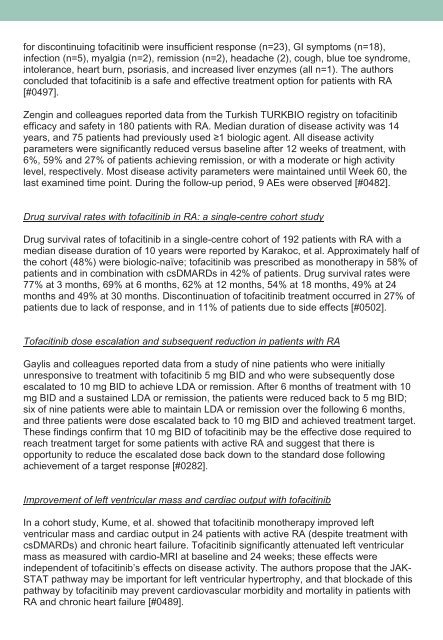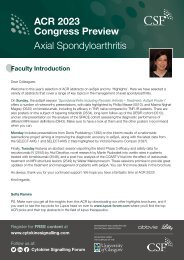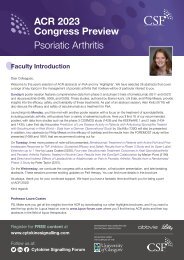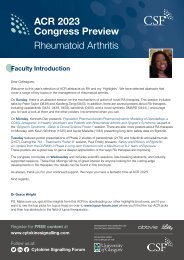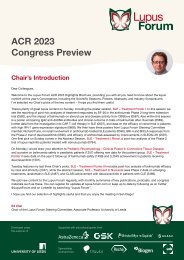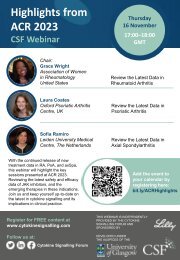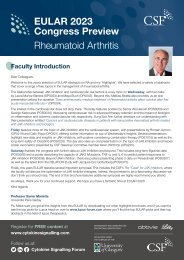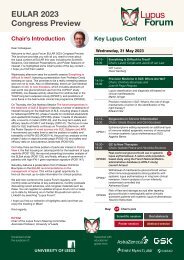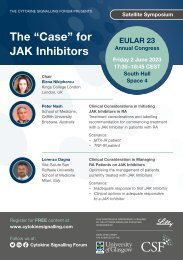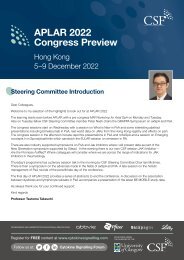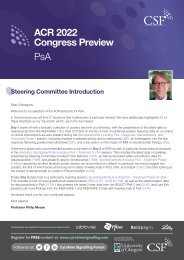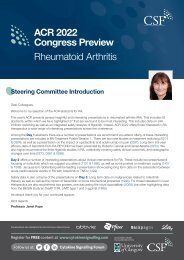EULAR 2018 Review
Create successful ePaper yourself
Turn your PDF publications into a flip-book with our unique Google optimized e-Paper software.
for discontinuing tofacitinib were insufficient response (n=23), GI symptoms (n=18),<br />
infection (n=5), myalgia (n=2), remission (n=2), headache (2), cough, blue toe syndrome,<br />
intolerance, heart burn, psoriasis, and increased liver enzymes (all n=1). The authors<br />
concluded that tofacitinib is a safe and effective treatment option for patients with RA<br />
[#0497].<br />
Zengin and colleagues reported data from the Turkish TURKBIO registry on tofacitinib<br />
efficacy and safety in 180 patients with RA. Median duration of disease activity was 14<br />
years, and 75 patients had previously used ≥1 biologic agent. All disease activity<br />
parameters were significantly reduced versus baseline after 12 weeks of treatment, with<br />
6%, 59% and 27% of patients achieving remission, or with a moderate or high activity<br />
level, respectively. Most disease activity parameters were maintained until Week 60, the<br />
last examined time point. During the follow-up period, 9 AEs were observed [#0482].<br />
Drug survival rates with tofacitinib in RA: a single-centre cohort study<br />
Drug survival rates of tofacitinib in a single-centre cohort of 192 patients with RA with a<br />
median disease duration of 10 years were reported by Karakoc, et al. Approximately half of<br />
the cohort (48%) were biologic-naïve; tofacitinib was prescribed as monotherapy in 58% of<br />
patients and in combination with csDMARDs in 42% of patients. Drug survival rates were<br />
77% at 3 months, 69% at 6 months, 62% at 12 months, 54% at 18 months, 49% at 24<br />
months and 49% at 30 months. Discontinuation of tofacitinib treatment occurred in 27% of<br />
patients due to lack of response, and in 11% of patients due to side effects [#0502].<br />
Tofacitinib dose escalation and subsequent reduction in patients with RA<br />
Gaylis and colleagues reported data from a study of nine patients who were initially<br />
unresponsive to treatment with tofacitinib 5 mg BID and who were subsequently dose<br />
escalated to 10 mg BID to achieve LDA or remission. After 6 months of treatment with 10<br />
mg BID and a sustained LDA or remission, the patients were reduced back to 5 mg BID;<br />
six of nine patients were able to maintain LDA or remission over the following 6 months,<br />
and three patients were dose escalated back to 10 mg BID and achieved treatment target.<br />
These findings confirm that 10 mg BID of tofacitinib may be the effective dose required to<br />
reach treatment target for some patients with active RA and suggest that there is<br />
opportunity to reduce the escalated dose back down to the standard dose following<br />
achievement of a target response [#0282].<br />
Improvement of left ventricular mass and cardiac output with tofacitinib<br />
In a cohort study, Kume, et al. showed that tofacitinib monotherapy improved left<br />
ventricular mass and cardiac output in 24 patients with active RA (despite treatment with<br />
csDMARDs) and chronic heart failure. Tofacitinib significantly attenuated left ventricular<br />
mass as measured with cardio-MRI at baseline and 24 weeks; these effects were<br />
independent of tofacitinib’s effects on disease activity. The authors propose that the JAK-<br />
STAT pathway may be important for left ventricular hypertrophy, and that blockade of this<br />
pathway by tofacitinib may prevent cardiovascular morbidity and mortality in patients with<br />
RA and chronic heart failure [#0489].


